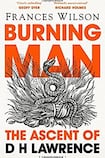
In Burning Man, Frances Wilson aims to rescue DH Lawrence from his post-feminist infamy. “Both censored and worshipped in his lifetime,” writes the acclaimed biographer, “Lawrence’s afterlife has been one of peaks and troughs.” Having been “hailed as the mascot of the sexual revolution” after the 1960 release of the unexpurgated version of Lady Chatterley’s Lover, Lawrence was “cancelled” a decade later – felled for phallocentrism by feminist writer and activist Kate Millett in her book Sexual Politics.
Despite The Rainbow and Women in Love having been proclaimed part of the canon by literary critic FR Leavis, Wilson agrees with Geoff Dyer’s assertion in Out of Sheer Rage: In the Shadow of DH Lawrence (1997) that Lawrence’s novels are not his greatest achievement. The genius is found in his lesser-known works, such as an introduction to American writer Maurice Magnus’s Memoirs of the Foreign Legion, now out of print.
Considered the father of autofiction, “no writer before Lawrence had made so permeable the border between life and literature,” writes Wilson, “or held so fast to his native right to put everything he was into a book”.
Burning Man covers Lawrence’s middle years, a “decade of superhuman energy and productivity” from 1915, when he was 30, to 1925. While the peripatetic lifestyle with his wife, Frieda von Richthofen, may seem chaotic, Wilson frames the “journey in terms of descent and ascent”, identifying three periods in line with the cantiche of Dante’s Divine Comedy. The allegory is topographic in addition to spiritual, as Lawrence mounted ever-higher planes to ward off the tuberculosis that would take his life in 1930.
Lawrence’s “Inferno” (1915-1919), spent in Cornwall, was the era in which he published The Rainbow and despaired about the war. After eloping with Frieda, the couple was under surveillance on suspicion of spying due to her German origins, to the point of being chased out of Cornwall “by a pitchfork-wielding mob”.
The period also contained what Lawrence considered "one of the crises" of his
life, the moment when he realised that English economist John Maynard Keynes was bisexual. Despite strong indications that he was himself attracted to men, Lawrence was repelled by homoerotic manifestations, calling homosexuality "so wrong, it is unbearable".
When the literary community failed to defend him over the banning of The Rainbow – a ruling thought to have less to do with obscenity than its author’s anti-military stance – Lawrence came to consider England enemy territory. The couple eventually exiled themselves, living in Sicily from 1920 to 1922.
Lawrence left behind what he called his “serious English novels”, the last of which was Aaron’s Rod (1922), whose “madness is bound up with its badness”, writes Wilson. During what she deems his purgatorial era, he embarked on travel writing: “Comes over one an absolute necessity to move,” begins Sea and Sardinia (1921). In Italy, Lawrence became financially and possibly sexually entangled with Magnus, in a climate and culture more hospitable than England had been.
Paradise, in Wilson’s telling, was Lawrence’s time in New Mexico, after a three-month stint in Australia during which he wrote the novel Kangaroo (1923). He was invited to Taos by the arts patron Mabel Dodge Luhan, a stay recounted in her memoir Lorenzo in Taos (1932) and recently credited as a loose inspiration for Rachel Cusk’s Second Place (2021).
In Burning Man, a portrait of Lawrence as a character emerges in relation to his colourful entourage, which at various times included Hilda Doolittle, Katherine Mansfield and Norman Douglas; many of them published memoirs of their time with him. “Isn’t it remarkable how everyone who knew Lawrence felt compelled to write about him?” observed Aldous Huxley, who edited his letters posthumously.
A literary critic and former academic, Wilson has previously examined lives including Thomas De Quincey, Bruce Ismay and Dorothy Wordsworth. In Burning Man, the link to the Divine Comedy is tenuous and Wilson’s writing meanders at times. Nevertheless, the book is a thoroughly researched addition to previous biographies.
In her view, the effects of tuberculosis on Lawrence’s life and work are not to be underestimated. “One sheds one’s sicknesses in books,” he once wrote in a letter. Despite the embodiment infusing his writing, his own body failed him throughout his life.
While his homophobic, anti-Semitic and xenophobic comments are troubling, Lawrence’s irascibility – which Wilson pins on his illness – encompassed everyone. When the publisher Heinemann rejected the manuscript of Paul Morel, for example, he cursed “the blasted, jelly-boned swines, the slimy, the belly-wriggling invertebrates, the miserable sodding rotters, the flaming sods, the snivelling, dribbling, dithering palsied pulse-less lot that make up England today”.
Wilson truncates her tale in 1925, skimming over the drama surrounding the publication of Lady Chatterley’s Lover (1928), though she both flashes back to Lawrence’s youth and addresses his death.
Burning Man ends on an arresting image: among multiple mythologies of the fate of Lawrence’s ashes, one version has them consumed by Frieda, Mabel and the painter Dorothy Brett, another member of the Taos menage. Accompanied by a photo of the trio grinning, Wilson likens them to the “three blessed women” invoked by Virgil – Beatrice, the Virgin Mary and Saint Lucia: guardian angels who eased Dante’s passage in the afterlife.


